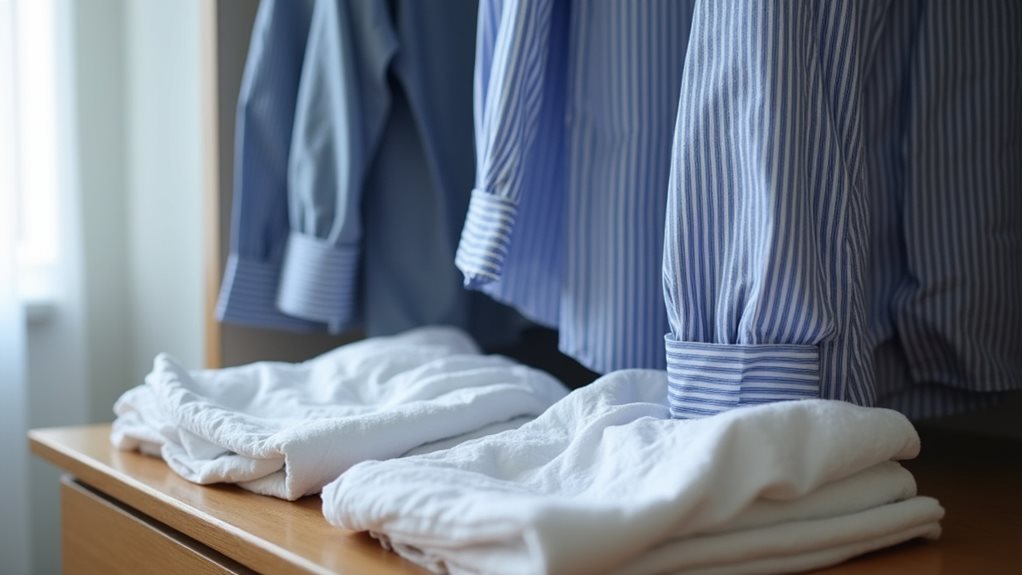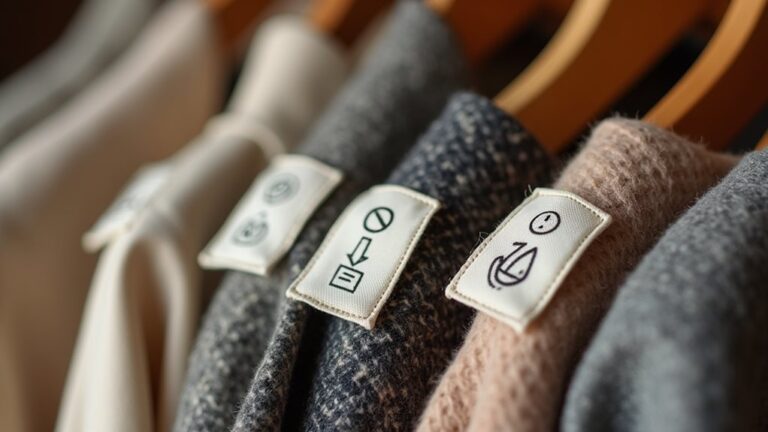Dry cleaning sheets absolutely work for revitalizing clothes and eliminating odors, though they’re more like a gentle touch-up than deep cleaning magic. You’ll find them surprisingly effective on light surface stains and perfect for maintaining delicate fabrics like silk between professional cleanings, but don’t expect miracles on that pasta sauce disaster from last week. At roughly $1-2 per garment versus $10-25 for professional services, they’re budget-friendly heroes for everyday maintenance, and there’s plenty more to discover about maximizing their potential.
What Are Dry Cleaning Sheets and How Do They Function
When I first discovered dry cleaning sheets tucked away in the laundry aisle, I’ll admit I was skeptical—another gimmicky product promising miracles, right?
But these ingenious little squares actually work through some pretty clever chemistry that transforms your regular dryer into a home dry cleaning powerhouse. You simply toss these specially designed fabric sheets into your dryer with your clothes, and the heat activates moisture-releasing chemicals that create steam to relax fabric fibers and eliminate stubborn odors.
The sheets coat your garments with softening lubricants while imparting fresh scents, making them feel professionally cleaned.
What’s particularly impressive is their versatility—you can safely use dry cleaning sheets on delicate materials like silk and wool, bringing professional-quality care right to your laundry room without harsh chemicals or expensive trips to the cleaners. Unlike traditional dry cleaning which uses chemical solvents to remove stains and dirt, these sheets offer a water-free alternative for refreshing garments at home.
Effectiveness on Different Types of Stains and Fabrics

You’re probably wondering if these convenient little sheets can tackle that stubborn coffee stain on your favorite blouse, or whether they’ll work on your delicate silk scarf without causing damage.
The truth is, dry cleaning sheets perform quite differently depending on what type of stain you’re dealing with and what fabric you’re treating, which means understanding their strengths and limitations will save you from disappointment (and potentially ruined clothes 😅).
While they’re surprisingly gentle on materials like wool and cotton, their stain-fighting power varies greatly between light surface marks and those deeper, set-in disasters that seem to laugh in the face of home remedies.
For oil-based stains specifically, these sheets typically can’t match the effectiveness of professional dry cleaning, which uses specialized chemical solvents like perchloroethylene that are specifically designed to dissolve and lift grease that water-based methods cannot remove.
Stain Removal Performance
Although I’ve watched countless commercials promising miracle stain removal, my real-world experience with dry cleaning sheets has taught me they’re more like helpful assistants than superhero cleaners.
When you’re dealing with light coffee spills or everyday sweat marks, these home dry cleaner sheets work surprisingly well, especially on cotton shirts and blended fabrics.
However, don’t expect them to tackle that red wine disaster from last week’s dinner party – they’re simply not that powerful of a stain remover.
I’ve learned that spot-treating stubborn marks before tossing garments in with the sheets dramatically improves results.
While they’ll refresh your clothes beautifully and handle most water-based stains, remember they can’t replace professional dry cleaning for serious cleaning challenges.
For comparison, professional dry cleaning uses specialized chemical solvents instead of water, making it far more effective at removing oil-based stains, grease, and makeup that home dry cleaning sheets simply cannot handle.
Fabric Type Compatibility
After years of experimenting with different fabrics in my dryer, I’ve discovered that dry cleaning sheets have distinct personalities when it comes to various materials, and understanding these quirks can save you from some pretty embarrassing wardrobe mishaps.
Most dry cleaning kits excel with fabric type compatibility across these materials:
- Cotton and blends – They absolutely love these everyday fabrics, softening them beautifully while banishing static.
- Silk and cashmere – Handle these delicate darlings with confidence, as the sheets treat them gently.
- Casual and formal wear – Both respond well, though I’ve learned formal pieces need extra attention.
- Heavily beaded garments – Proceed with caution here, as chemicals might clash with embellishments.
- Similar fabric weights – Group these together to prevent color bleeding disasters.
While dry cleaning sheets work well for many fabrics, traditional dry cleaning with chemical solvents remains superior for structured garments like suits and formal wear that require professional pressing and stain removal.
Trust me, respecting these fabric personalities will keep your wardrobe happy!
Cost Comparison With Professional Dry Cleaning Services
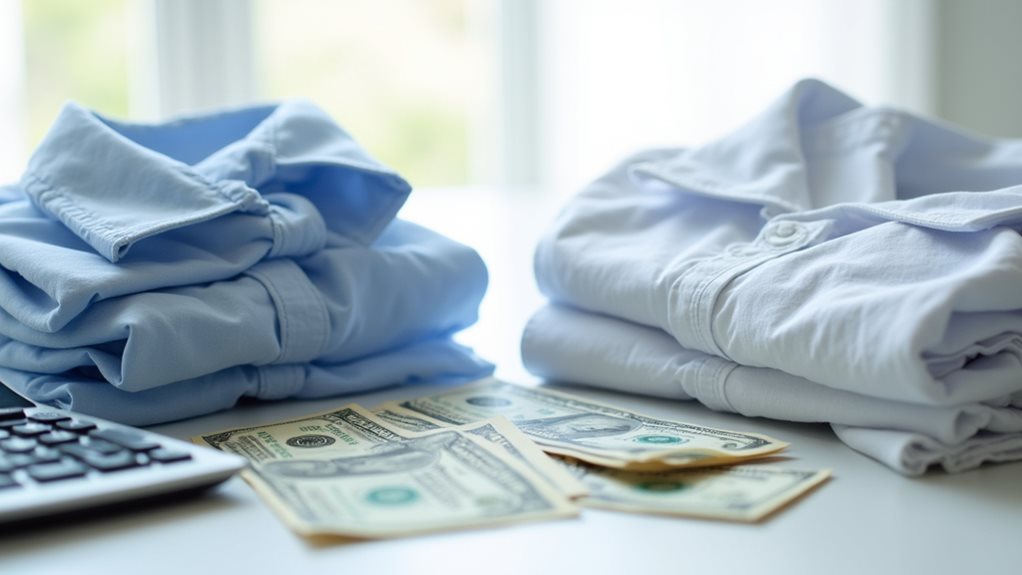
When you’re weighing whether dry cleaning sheets actually save money, you’ll want to compare what you’re currently spending at the professional cleaners against the upfront cost of home kits.
I learned this lesson the hard way after dropping $45 at the dry cleaner for three blazers last month, which made me realize I could’ve bought several boxes of cleaning sheets for that same amount.
Let’s break down the real numbers behind professional service pricing, home kit expenses, and what your long-term savings might look like when you crunch the math honestly.
Professional dry cleaning costs can vary significantly based on garment type, fabric complexity, your geographic location, and whether you need special treatments like stain removal or rush service.
Professional Service Pricing
Since I started keeping track of my dry cleaning expenses last year, I’ve been honestly shocked by how quickly those $15 charges per dress shirt add up, especially when you’re someone like me who spills coffee on white clothing with remarkable consistency.
When you really break down what your local dry cleaner charges, it’s eye-opening:
- Basic shirts and blouses: $10-15 per piece
- Suits and jackets: $15-25 each
- Delicate dresses: $12-20 depending on fabric
- Specialty items like silk ties: $8-12
- Comforters and heavy items: $25-40
That weekly cleaning run can easily hit $50-75, which means you’re spending hundreds monthly on garment care alone – money that could definitely find better uses elsewhere! 💸
These costs align with the fact that most Americans spend between $200 to $500 annually on professional garment care, with business professionals and urban dwellers typically falling on the higher end of this range.
Home Kit Costs
Home dry cleaning kits present a completely different financial picture that honestly made me kick myself for not discovering them sooner.
You’ll spend around $15 to $30 for a starter kit, but here’s where it gets interesting – these home dry cleaning kits can clean multiple garments, typically 16 to 24 pieces per kit.
When you break down the math, you’re looking at roughly $1 to $2 per garment versus the $10 to $20 professional services charge.
I literally calculated my savings after three months and realized I could’ve bought myself a nice dinner with what I saved 😅.
Plus, many cleaning sheets can be reused several times, making each cleaning cycle even more economical for your wallet.
However, it’s important to understand the limitations of these home methods compared to professional services, as certain delicate garments may still require specialized care that only professional dry cleaners can provide.
Long-Term Savings Analysis
Although my initial savings seemed impressive enough, I decided to dig deeper into the actual long-term numbers because, honestly, I’m a bit of a spreadsheet nerd when it comes to household budgets 📊.
What I discovered about long-term savings absolutely blew my mind, and here’s what you need to know:
- You’ll save hundreds annually since a dry cleaner would charge $10-20 per garment versus $1-2 per sheet use.
- One box cleans 16-24 items simultaneously, maximizing your cost-effectiveness compared to per-item professional pricing.
- Your garments actually last longer because you’re avoiding the harsh wear from frequent dry cleaner visits.
- You’ll eliminate travel costs, pickup fees, and those annoying rush charges that professional services love adding.
- The convenience factor alone saves you precious time that’s worth real money.
Keep in mind that specialty items and delicate fabrics at professional dry cleaners command premium prices that can significantly increase your annual cleaning expenses.
Limitations and What They Cannot Clean
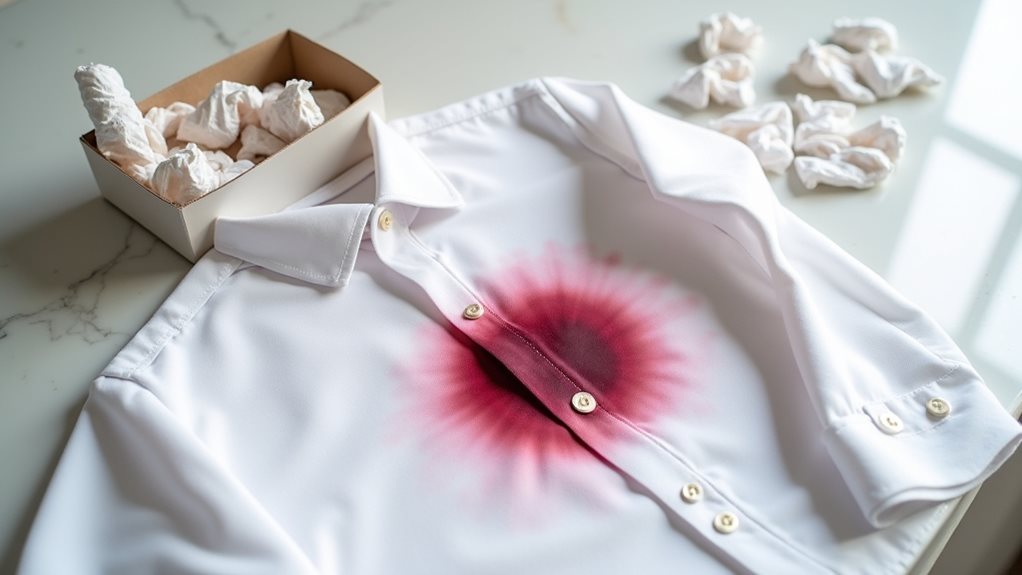
While dry cleaning sheets offer convenient freshening power for your wardrobe, they’re not miracle workers that can handle every cleaning challenge you’ll face.
Understanding their limitations helps you set realistic expectations and avoid disappointment when tackling stubborn stains or heavily soiled garments.
These sheets excel at deodorizing and light rejuvenation, but they can’t match professional cleaning’s deep-cleaning power. Heavy grime, set-in stains, and serious soil require more aggressive treatment than these gentle sheets provide.
You’ll also miss that crisp, pressed finish that formal wear demands—think wrinkled blazers that still look rumpled after treatment.
Certain fabrics are off-limits entirely: sequined dresses, beaded tops, suede jackets, and leather pieces can suffer damage.
Always spot-treat visible stains first, as the sheets primarily steam and deodorize rather than truly clean.
For truly stubborn stains, especially oil-based ones like grease and makeup, professional dry cleaning uses specialized chemical solvents that can break down these tough stains in ways that at-home dry cleaning sheets simply cannot replicate.
Best Practices for Optimal Results

Since you’ve invested in dry cleaning sheets, you’ll want to squeeze every ounce of effectiveness from them—trust me, I learned this the hard way after ruining a favorite silk blouse by rushing through the process.
Following these best practices will dramatically improve your cleaning effectiveness and save you from my costly mistakes:
- Read manufacturer’s instructions completely before starting, because skipping this step cost me a cashmere sweater 😅
- Spot-treat stains with included remover first, since dry cleaning sheets work better on fresh stains than set-in ones
- Group similar fabric weights and colors together to prevent lightweight items from getting crushed by heavier pieces
- Avoid overstuffing the bag, allowing proper steam circulation for even cleaning results
- Clean your dryer’s lint filter beforehand for maximum efficiency and safety
Always test dry cleaning sheets on an inconspicuous area first, especially with delicate fabrics, since understanding fabric care labels is crucial for preventing damage to expensive garments.
Environmental Impact and Safety Considerations
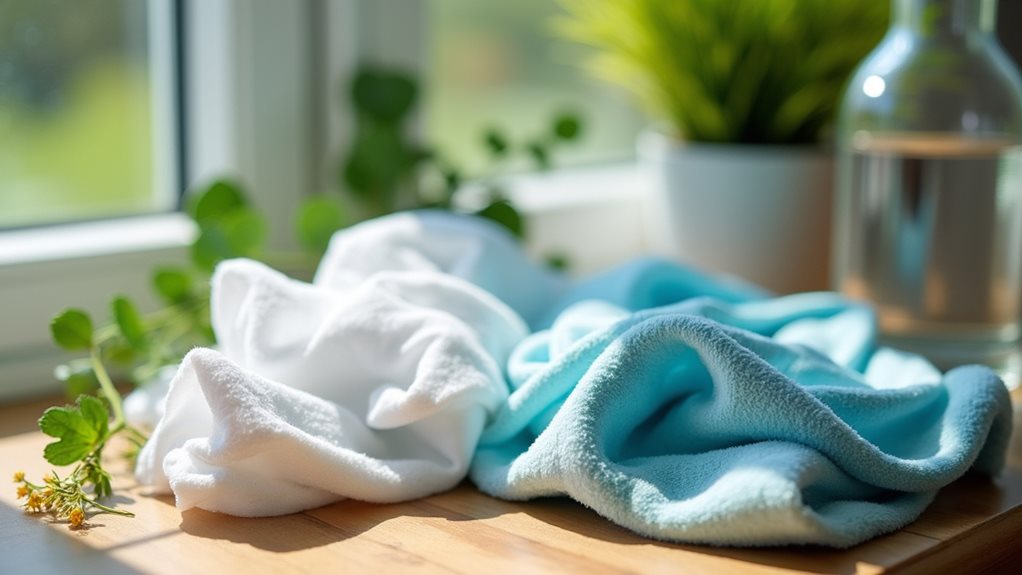
When I first discovered dry cleaning sheets, my environmentally-conscious daughter challenged me to research their impact on our planet, and honestly, what I found surprised me in the best possible way.
Unlike your typical dry cleaner’s harsh chemicals like perchloroethylene (which sounds as scary as it is), these sheets use biodegradable ingredients that won’t haunt future generations.
You’re also cutting down on carbon emissions since you’re not driving back and forth to the cleaners every week – my Honda thanks me for the break!
The non-toxic formulas mean you won’t deal with those headache-inducing fumes, and many sheets are reusable, so you’re creating less waste overall.
It’s invigorating when convenience actually aligns with doing good. 🌱

